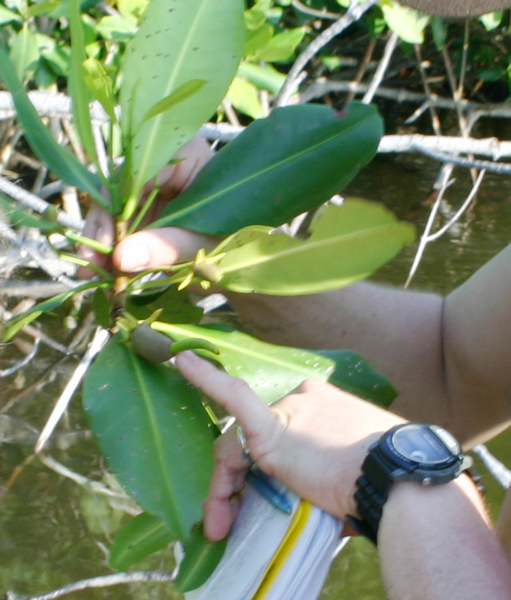- Rhizophora mangle
Taxobox
name = "Rhizophora mangle"

image_width = 240px
image_caption = "R. mangle" branch with germinating seed, inGuanacaste ,Costa Rica .
regnum =Plant ae
divisio = Magnoliophyta
classis =Magnoliopsida
ordo =Malpighiales
familia =Rhizophoraceae
genus = "Rhizophora "
species = "R. mangle"
binomial = "Rhizophora mangle"
binomial_authority = L."Rhizophora mangle", known as the red mangrove, is distributed in estuarine ecosystems throughout the tropics. Its
viviparous seeds, which are dispersed by water, sprout while they are still on the parent plant, growing a tough green root that makes them unmistakable."R. mangle" grows on prop roots, which arch above the water level, giving stands of this tree the characteristic "
mangrove " appearance. It is a valuable plant in Florida, Louisiana, and Texas costal ecosystems. In its native habitat it is threatened by invasive species such as the Brazilian Pepper Tree. The Red Mangrove itself is considered aninvasive species in some locations, such asHawaii , where it outcompetes native vegetation and forms dense,monospecific thickets. "R. mangle" thickets, however, are known to provide nesting and hunting habitat for a diverse array of organisms, includingfish ,bird s, andcrocodile s.Habitat
Red Mangroves are found in
subtropical andtropical areas in bothhemispheres , extending to approximately 28°. They thrive on coastlines inbrackish water and in swampy salt marshes. Because they are well adapted to salt water, they thrive where many other plants fail and create their own ecosystems, themangal s. Red mangroves are often found near white mangroves (Laguncularia racemosa ), black mangroves (Avicennia germinans ), and buttonwood (Conocarpus erectus ). Though these plants are only distantly related, they serve a similarecological purpose. Red Mangroves are usually the dominant species. Through stabilisation of their surroundings, mangroves create a community for other plants and animals (such as themangrove crab ) to survive. Though rooted in soil, mangrove roots are often submerged in water for several hours or on a permanent basis. The roots are usually sunk in asand orclay base which allows for some protection from the waves.Description
Red Mangroves are easily distinguishable through their unique
prop root system andviviparous seed s. The prop roots of a red mangrove suspend it over the water, thereby giving it extra support and protection. They also help the tree to combatanaemia by allowing it a direct intake of oxygen through itsroot structure.A mangrove can reach up to 80 feet in height in ideal conditions, however it is commonly found at a more modest 20 feet. Its bark is thick and a grey-brown color. Mangrove leaves are 1”-2” long and 3”-5” wide, with smooth
margin s and an ellipse shape. They are a darker shade ofgreen on the tops then on the bottoms. The tree produces pale yellow flowers in the spring.Reproduction
As a viviparous plant, the mangrove creates a fruit that is in reality a living tree. Through resembling an elongated
seedpod , the fruit on the mangrove is capable of rooting at any time and producing a new tree. The trees arehermaphrodite s, capable ofself-pollinating orwind-pollinating . The tree undergoes no dormant stage as a seed, but rather progresses to a live plant before leaving its parent tree. A mangrove sapling may float in brackish water for over a year before rooting. It has been proposed that the life cycle of the red mangrove is in some unknown way linked tohurricane cycles, though this has never been proven.ee also
*
Mangrove
*Salt marsh
*Wetland External links
* [http://www.cas.vanderbilt.edu/bioimages/species/frame/rhma2.htm "Rhizophora mangle" images at bioimages.vanderbilt.edu]
*http://www2.dpi.qld.gov.au/fishweb/2635.html More detailed information on the Red Mangrove.
Wikimedia Foundation. 2010.
